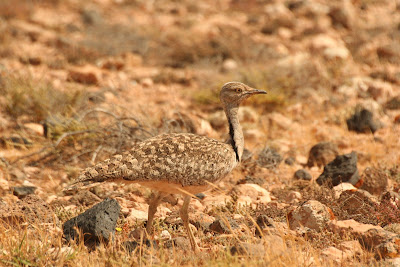The thing about Canary birding is the fact that a) the birds are found in all sorts of odd places, and b) there's a sense that literally anything can turn up anywhere. Add this to the number of endemic species and subspecies and the Canaries are one of the hottest birding/wildlife destinations around.
Even from my cheesy hotel balcony in El Medano on Tenerife I was able to see Plain swifts, Berthelot's pipits, Yellow-legged gulls, Spanish sparrows and Canary Islands Chiffchaffs - not a bad start on day one.
El Medano is a prime example of the strangeness of Tenerife birding experiences - here you have a Canarian version of Clacton-on-sea, full of bars, fast-food joints and sunbathers (although the Spanish generally tend to look more attractive with few clothes on) - and yet it is the last stronghold of breeding Kentish plover on the island. The birds are resident all year, and when the beach is packed they mooch off into the nearby sand dunes to escape. Unluckily I didn't manage to see them this time due to the prevalence of dog walkers - maybe their time is really up??
The saltwater pool behind the beach is usually good for a few migrant waders but again the beach traffic was too much and the site was empty, bar a couple of whimbrel on the nearby rocks. Compensation came in the form of a steady passage of westward-heading Cory's shearwaters just off the coast.
Pine Forest
Of Tenerife's four main ecological zones, the Pinars are perhaps the most exciting for me personally as they are home to my all-time favourite bird, the Blue chaffinch. There had been a major forest fire in the north of Tenerife and the evidence was clear to see - in some areas the pines were totally hammered with no crown left at all. In other areas though the regeneration was well under way...

Due to the fire, the available feeding areas for Blue chaffinch have been reduced and so the birds seem to be forming small groups and exploiting the scattered crops of pine seeds - I saw one group of about 8 birds, mixed male and female.

No squirrels on Tenerife...must be the woodpeckers...
Las Lajas...a pine forest site with Blue chaffinches on tap...
Canariensis Great spotted woodpecker and male Canary - it's amazing what a dripping tap can bring in...
 An unmistakeable silhouette.
An unmistakeable silhouette.
Fuerteventura
Although Tenerife can provide some amazing birding, the desert species are fairly low on the ground (mostly due to the complete ravaging of lowland areas) and so a short flight east to Fuerteventura can yield some specialities more typical of north Africa, plus a cracking endemic.
Being a largely parched island, any greenery or water tends to be the spot to see birds, but there are some that like it hot...
Houbara!!
One of the key species on the island is the mighty Houbara, a mystical desert bird that's bloody hard to see...or so you might think...
Although the north of the island, towards Corralejos, has numerous bustard-shaped road signs the best spot to see this bird is the flat rocky desert encircling Tindaya. Anywhere around Tindaya mountain, particularly seawards, is good...and so after a very short search I found this beast...
A stunning bird - everything you want it to be...
Barbary falcon...putting the willies up the local pigeons!
Catalina Garcia reservoir
This small reservoir is a magnet for birds in this parched landscape. It even has a brand-new hide (locked!) and enables cracking views of a range of species - I managed Ruddy shelduck (breeding), Spoonbill, Grey heron, Little egret, Black-winged stilt, Dunlin, Kentish plover, Little Ringed plover, Yellow-legged gull, Redshank, Lesser Short-toed lark and Southern grey shrike.
Ruddy shelduck with young.
Admirable sentiment...shame about the translation....
Barbary Ground squirrel...every pile of rock has got one of these cheeky buggers on top - I had to throw stones at one when I trying to photograph the chat - bloody thing wouldn't stop scolding me!
Always a pleasure to see Hoopoes...particularly common around La Oliva
Algerian hedgehog (deceased)
Canary Islands stonechat - not an easy bird to get near!
Back on Tenerife...
Arriving back on Tenerife in the middle of a Saharan sandstorm, I had a few more days of birding...now with the promise of a few off-course migrants. First though, it was off to see some of the islands most endangered residents...Rock sparrow.
The last 8 birds ion the east of the island are hanging on in an abondoned building near La Esperanza, sharing their grubby breeze-block home with Plain swifts and Bert's pipits.
One of the 8 birds in eastern Tenerife...very shy and flighty.
A very obliging Linnet...
Berthelot's pipit.























1 comment:
I chanced upon your blog while trying to find out why blue cranes did not continue their migration to Africa this year, but stayed in Agmon Huhula Lake area. Didn't find the answer to my question, but did enjoy your blogs and fabulous pictures. Priali
Post a Comment